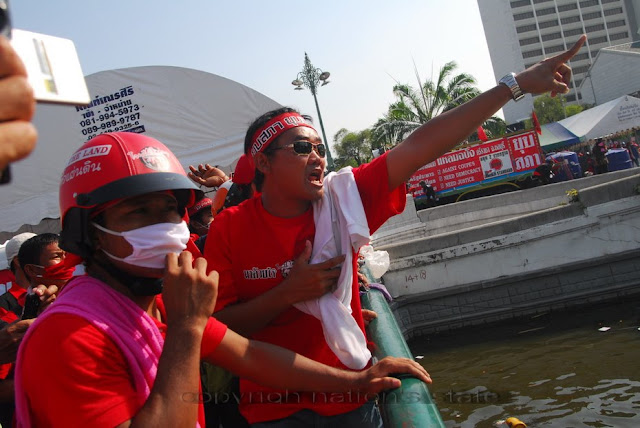Blood stained stairs on Silom where one of the M79 grenades landed, the sticker reads: "we love the king"
Briefly, as I am on the way to Silom again tonight, I am posting some images from last night's violence on Silom road.
I arrived after the M79 grenades had exploded. For comments on such violence and the general state of ungovernability in Thailand see
M79's and Ungovernability.
When I arrived, mob violence by PAD (yellow shirts, multicolored shirts, or whatever name they are using today) was in full swing and they were again setting upon people they suspected were reds.
Yet violence mostly raged between the PAD and the red frontline. Both sides fought spiritedly and the sound of breaking bottles, breaking windows, vulgar insults, and thousands of metal pieces of debris
ricocheting off walls, cars, and signs was non-stop.
Police were doing nothing.
At one point, some police tried to clear the PAD but were violently rebuffed by the mob.
PAD members complained bitterly that the police were not protecting them from the reds. This was also in relation to the M79 attacks which had caused the PAD to scream and hiss at the police while cheering when military troops moved through the lines.
Things further degenerated with skirmishes raging between the PAD and the reds and between the PAD and the police.
While police tried to hold their lines, the PAD pelted them with bottles and rocks launched from slingshots.
The whole time, rocks and other metal objects were being launched at the PAD from the red's fortified barrier. Reds also launch a number of fireworks at the PAD and there were many loud explosions that were likely fireworks.
While tensions were high, a moment of levity came when a PAD member with a slingshot ran up to a couple of journalists taking shelter behind a firetruck, and while scanning the ground, ask if anyone had a flashlight to help him find rocks or other ammunition for his slingshot. We all laughed, wished him luck, but we would be somewhat compromised to help in the fray.
At about 11:40 pm, the police were either ordered to clear the PAD or had simply had enough of being at the receiving end of the hostility.
Police formed a line at the end of Silom road, started thumbing their truncheons against their shields, and then began moving into the PAD.
The PAD threw rocks, bottles, sticks, metal barriers, and tried to drag razor wire in front of the police as they retreated down the street. One guy even swung a large fire extinguisher at the police (see bellow).
Once under the Sala Deang BTS station, the PAD were trapped by lines of military couched bellow their riot shields.
It was chaos as they funneled into the few spaces between troops as they were running in an open sprint with the cops right behind.
When the police caught them it was violent retribution. Those that struggled were beaten.
It was another ugly night of violence on Silom road and likely not the last.
Note the small boy firing the sling shot, this is the second night he has been there. He is about 12 years old.





















































